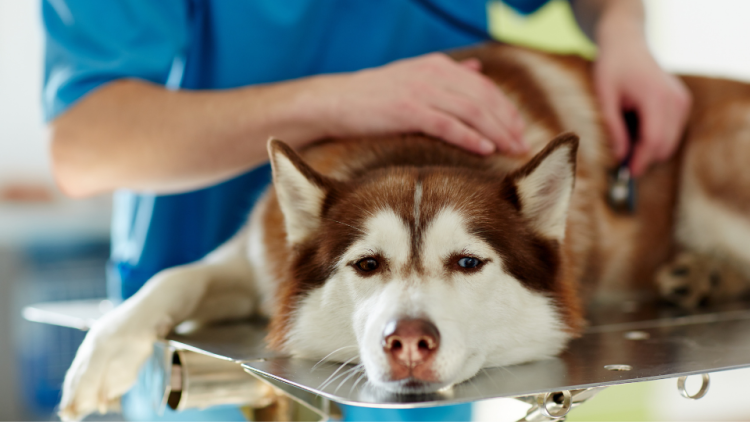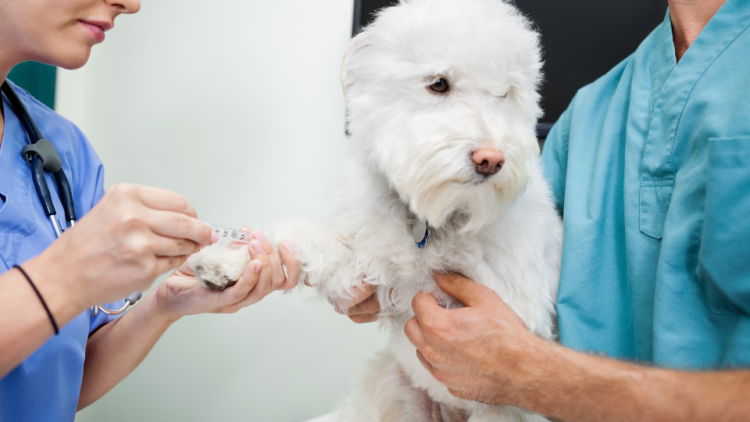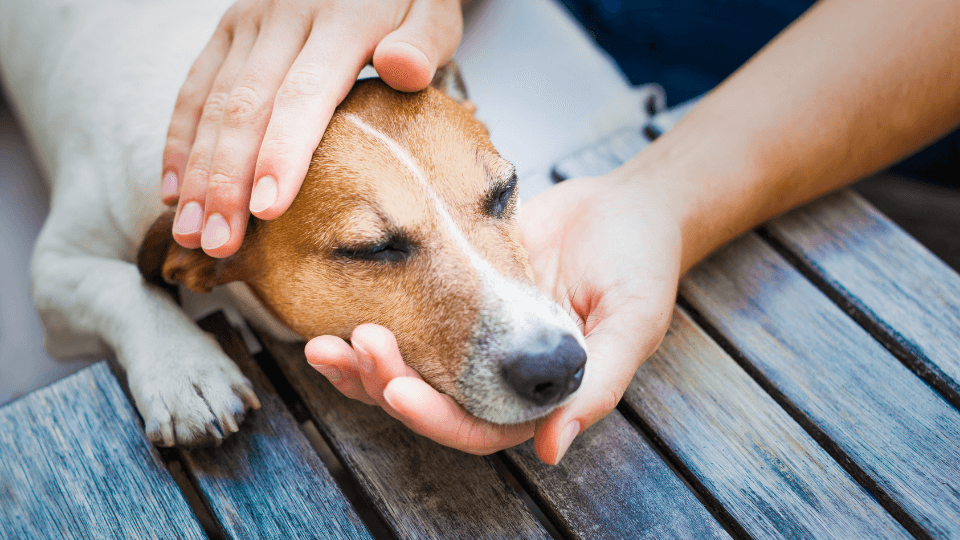Addison’s disease, also known as canine hypoadrenocorticism, is a condition that can have serious consequences for dogs. Fortunately, proper treatment can help ensure that dogs with Addison's disease lead normal lives.
Keep reading to find out more about the symptoms of Addison’s disease in dogs, how it's diagnosed, the available treatment options, and more.
Table of Contents:
- What is Addison’s disease in dogs?
- What causes Addison’s disease?
- What are the symptoms of Addison’s disease?
- What triggers Addison's disease symptoms?
- What is an Addisonian crisis?
- How is Addison's disease diagnosed?
- How do you treat Addison's disease in dogs?
- How much does it cost to treat Addison’s disease?
- Can you prevent Addison's disease?
- Key Takeaways
Pro Tip: Having a pet insurance policy for your canine friend can help manage the cost of medication they will need to battle Addison’s disease, which can run thousands of dollars for diagnosis and treatment.
What is Addison’s disease in dogs?
Addison’s disease in dogs refers to a drastic decrease in the production of cortisol and aldosterone, two steroid hormones produced in the adrenal glands responsible for a wide number of jobs. Also known as hypoadrenocorticism, leading to a deterioration of health that can have serious consequences, including death.
Cortisol is a glucocorticoid, a type of steroid hormone that works with the immune system to address a number of health problems. An elevation of glucocorticoids is usually associated with stressful events - which is why cortisol is commonly known as the stress hormone - and plays a role in:
- Metabolizing proteins, fats, and carbohydrates
- Controlling the production of glucose (sugar)
- Stimulating the formation of red blood cells
- Regulating blood pressure
- Suppressing the immune system
- Reducing inflammation
Aldosterone is a mineralocorticoid, a class of steroid hormones that influence the body’s salt and water balance (or the ratio of electrolytes to fluids). It regulates the concentration of potassium, chloride, sodium in the body. When the production of mineralocorticoids is disrupted, it can lead to problems with the heart, kidneys, and cardiovascular system.
What causes Addison’s disease?
Addison's disease causes are still unknown, but veterinarians believe that most cases result from autoimmune destruction of the adrenal gland. In less common cases, the adrenal gland can be damaged by cancer, infarction, and hemorrhage.
Addison’s disease can also occur following the treatment of hyperadrenocorticism (Cushing’s disease), in which there is an increase in cortisol and aldosterone levels. In this case, the drugs used to treat hyperadrenocorticism unintentionally damage the adrenal gland or suppress too much of its activity, resulting in adrenal insufficiency.
Secondary Addison's disease causes include tumors and disorders of the pituitary gland, which is essential to the controlled functioning of endocrine glands. A secondary form of the disease can also occur if a dog has been treated with steroids for a long time and the medication is suddenly discontinued.
Any canine can develop the condition, but certain dog breeds are more susceptible to Addison’s disease. The list includes:
- Poodles
- Bearded Collies
- Soft Coated Wheaten Terriers
- Leonbergers
- Labrador Retrievers
- Rottweilers
- West Highland White Terriers
- Nova Scotia Duck Tolling Retrievers
- Portuguese Water Dogs
- Great Danes
Additionally, studies have shown that 75% to 80% of dogs with hypoadrenocorticism are young females, which suggests a genetic origin that is not yet understood.

What are the symptoms of Addison’s disease in dogs?
Addison's disease symptoms are very vague because they include vomiting, diarrhea, lethargy, depression, lack of appetite (anorexia), weight loss, bloody stools, hair loss (alopecia), increased drinking and urination, as well as dehydration, low temperature, uneven heart rate, weak pulse, a painful abdomen, shaking, recurrent bouts of gastroenteritis1, hyperpigmentation, and hypoglycemia.
Most of these clinical signs are considerably vague as they tend to indicate other illnesses and diseases that might be present.
A small subset of dogs with Addison's disease will have normal mineralocorticoid and low cortisol levels. If electrolyte abnormalities don’t develop in the next few days or weeks, these dogs are referred to as having atypical hypoadrenocorticism. This type of Addison's disease is thought to be caused by a lack of glucocorticoids.
What triggers Addison's disease symptoms?
Dogs with Addison's disease can’t produce enough cortisol and cannot properly respond to stress, so symptoms are often triggered or worsened by stress-inducing stimuli.
What is an Addisonian crisis?
In some cases, the disease can manifest with more severe clinical signs such as severe diarrhea and vomiting, sudden weakness, and even collapse. This is called an Addisonian crisis2 and is considered a life-threatening emergency that requires immediate hospitalization.
How is Addison's disease diagnosed?
In most cases, an Addison's disease diagnosis occurs after a crisis situation in whch dogs to experience severe clinical signs. That’s why it's important to consult your veterinarian if you notice any changes to your dog’s health or behavior - even those you might consider minor, such as diarrhea or lethargy - to proactively detect the disease before an emergency happens.
How to test for Addison's disease
Once the Addisonian crisis is resolved, the veterinarian will perform diagnostic tests, including a complete blood cell count and urinalysis to determine what caused these symptoms. Dogs with hypoadrenocorticism will not show a pattern of changes in their white blood cells, which is as a "stress leukogram" because the pattern is caused by cortisol.
The absence of a stress leukogram in a dog might be due to a cortisol deficiency, so it can serve as a clue to consider Addison's disease. Other indicators that can point to an Addison’s disease diagnosis include:
- Unusually high urea and potassium levels
- disrupted levels of calcium, chloride, and sodium
- Low concentration of urine
- Insufficient oxygen transportation through red blood cells (anemia)

The best way to make a definitive diagnosis of Addison’s disease in dogs is by using the ACTH stimulation test3, which measures the baseline cortisol concentration before and after injecting synthetic ACTH (adrenocorticotropic hormone).
The vet might need to run additional tests to confirm their Addison's disease diagnosis, such as:
- Natural plasma ACTH
- Basal cortisol levels
- Electrocardiogram
- Abdominal ultrasound
- Dog X-rays
These tests can help them rule out other illnesses that might be causing Addison's disease symptoms. In rare cases, a CT or MRI may be necessary to check whether there’s a problem with the pituitary gland.
How do you treat Addison’s disease in dogs?
When it comes to Addison's disease treatment, the first thing your veterinarian will do is to stabilize your dog from the crisis by hospitalizing them and putting them on an immediate fluid therapy of corticosteroids with a large dosage of intravenous fluids. Once the crisis has passed, the vet will prescribe replacement hormones.
Typically, vets prescribe an injectable medication like DOCP, which is administered about once a month, and a steroid (such as prednisone for dogs) that’s given on a daily basis. Since Addison’s disease isn’t curable, your dog will have to take the replacement hormone medications throughout the rest of their life.
Determining the correct dose for your dog will take time and requires multiple vet visits in the first few weeks following the diagnosis so they can measure your pet’s electrolyte and hormone levels. You’ll also need to bring your pet in every 26 days or so for a replacement hormone shot (or you can learn to do this at home). The vet will likely recommend blood work once a year to ensure the medication is working properly.
How much does it cost to treat Addison’s disease?
Typical costs for the Addison's disease diagnosis usually range between $500 and $1,500. The cost will depend on which tests your vet conducts based on the clinical signs and health issues your dog displays. If your pet needs intensive care during the diagnostic process, the bills will be much higher.
The monthly cost for Addison’s disease treatment can range from $50 to $200 a month, depending on the selected medications and the animal’s response to care. The vet costs involved with frequent blood work and urinalysis should also be taken into consideration.
Pro Tip: The value in pet insurance not only ensures the safety of your pet, but also prevents you from having to make a choice between financial stability and your dog’s quality of life in the evet you can't afford the necessary care out of pocket.
Prognosis and recovery for dogs with Addison's disease
Fortunately, dogs usually feel better within several days of treatment, and most symptoms of Addison’s disease are gone within two to four weeks. The majority of patients have a good prognosis and once they’ve been stabilized with the appropriate medications, most dogs resume normal lives.
If you suspect that your canine companion may have Addison’s disease, get in touch with your vet right away so you can improve your loved one’s quality of life as fast as possible.
Can you prevent Addison’s disease in dogs?
In most cases, no. Addison's disease is an underlying condition that you cannot prevent, with the exception of a medication-induced Addisonian crisis. If your pet is taking trilostane or mitotane, you should be aware of Addison’s disease symptoms, because an accidental overdose can cause a crisis. Be sure to keep these drugs out of your dog’s reach and monitor their medications carefully.
Although you can’t prevent Addison’s disease in dogs, you can proactively prepare for it through DNA testing that may reveal insight into the genetic pool of affected dogs and their first-degree relatives.
Key Takeaways
- Addison's disease in dogs (hypoadrenocorticism) is a condition that develops when the adrenal glands stop working properly, causing steroid levels to drop very low.
- The clinical signs of hypoadrenocorticism are often vague, which can make it very difficult to diagnose prior to an Addisonian crisis.
- Addison’s disease treatment involves replacement hormone medications and the outlook is usually very goo, but the disease can be fatal if left untreated.
- Pet insurance can help cover the cost of emergency treatment and diagnostic tests.
- Talk to your veterinarian for any questions or concerns you may have about your pet’s health.
References
- VCA Hospitals. "Gastroenteritis in Dogs" Accessed Mar. 26, 2021.
- Clinician's Brief. "Managing Canine Addisonian Crisis" Accessed Mar. 26, 2021.
- "Canine ACTH Stimulation Test" Accessed Mar. 26, 2021.
